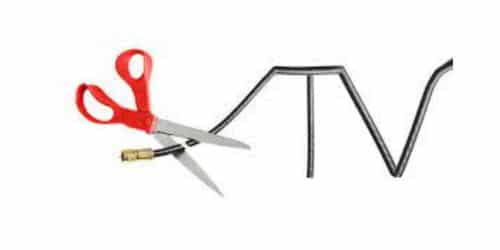The customer service and expenses of cable and satellite TV have many people “cutting the cord.” Cutting the cord is when a person stops using their regular cable or satellite provider in favor of a different method for watching TV. Making the switch is simple; however, there are a few things to take into account. Here is a guide for you on how to cut the cable wire with many alternatives.
Cut the Cable
In broadcast television, the term “cord-cutting” describes a pattern of viewers who, in response to competition from rival media available on the Internet, cancel their subscriptions to multichannel television services offered over cable or satellite, stop watching pay television channels, or cut back on the amount of subscription TV they watch. But you don’t need to spend days or weeks looking into the best ways to stop using cable TV when you’re just getting started with streaming TV.
Hence, there are just three ways to cut a cable, and they are seen below:
#1. Antenna
The antenna is how TV first emerged, and cord-cutters are bringing it back in a big way. You can get free programming from local and network affiliate TV stations that are broadcast over the air if you attach an indoor or outdoor antenna to your TV. This is a fantastic way to watch shows on the main TV networks, including ABC, CBS, NBC, Fox, WB, and PBS.
#2. Streaming
You can watch TV shows and movie content without an antenna or cable/satellite service if you have a smart TV, media streamer box, or stick (such as a Roku, Amazon Fire TV, Google Chromecast, Apple TV, etc.), or smart Blu-ray Disc player and pay for internet service.
#3. Combination of Antenna and Streaming
This is the most complete cord-cutting solution because it gives you free access to local TV channels as well as additional online material. Cutting the cord is obviously appealing due to the availability of the aforementioned cable/satellite subscription alternatives. However, there are advantages and disadvantages.
Let’s examine the cord-cutting findings in more detail.
#1. Lower Costs and No Contract
You are no longer obligated to pay for pricey cable service or be bound by a satellite agreement. Each service does have a fee, but the absence of a binding contract allows you to experiment with different services as you go. Remember that if you decide to end your satellite subscription, you can be charged an early termination fee.
#2. A La Carte Channel Selection
What channels and services you want are up to you. Unless you pay a monthly fee for a service like Hulu or Sling, you don’t have to pay for the channels and shows you don’t want.
#3. Lower Equipment Costs
Although a smart TV, media streamer, and/or antenna are still necessary to access the channels and shows you desire, those costs are one-time expenses rather than the ongoing monthly charges associated with renting a cable or satellite box.
#4. Watch on Portable Devices
You may watch streaming material on smartphones and tablets in addition to TVs. If there is internet access, this is wonderful for when you are traveling or otherwise not at home. Given the size of today’s smartphone screens, it’s not difficult to watch the news or catch a show while standing in line.
#5. Not Everything Is Free
Although many streaming channels and over-the-air TV reception are free, many other streaming channels and services charge a monthly subscription or pay-per-view price. You can spend less money than cable or satellite if you only pay for one or two subscription-based or pay-per-view services. The costs can build up, though, and you can once more find yourself with a sizable monthly subscription or pay-per-view expense that rivals that old cable/satellite bill.
#6. You May Still Need Cable or Satellite
Even if you choose to stream, some streaming services still demand that you have a current cable or satellite subscription in order to access them. Although it’s uncommon, it does occasionally happen.
In other words, despite the fact that some of the channels you enjoyed on your cable or satellite service can be downloaded via streaming for free when you try to utilize certain streaming platforms that also have cable channel equivalents, you might be asked to prove that you also receive that channel via a cable or satellite service.
#7. Streaming Limits
Be mindful of any restrictions on the amount of video you can broadcast each month if you decide to stream all of your TV content. SD or HD streaming is typically not a problem, but 4K streaming may use up a significant portion of your monthly allotment. Furthermore, the amount of your allocation you consume (as well as the speed of your internet service) will depend on how many people in your home are simultaneously streaming. The more you use the internet, the more you pay.
Benefits of Cutting the Cord
- Maybe lower prices.
- No agreement for satellite or cable.
- No ongoing rental fees for a cable or satellite box.
- Only pay for the channels and services you use.
- Utilize an antenna to get free local channels.
- Smartphones and tablets can also be used to view streaming services.
Drawbacks of Cord Cutting
- Streaming services are not always free.
- For some streaming services, you might need to keep your cable or satellite subscription.
- No smart TV or streaming device provides all services.
- The amount of streaming you may do without incurring extra fees may be restricted by monthly internet data restrictions.
Best Way to Cut the Cable
#1. Upgrade Your Internet Speed
We’ll presume you have access to the internet since you’re reading this in the twenty-first century. You need the quickest internet service you can find if you want to stream TV. Most streaming TV services advise at least 7 Mbps (megabytes per second) of download speed for their service; we say at least 25-100 Mbps, in order to prevent buffering and lag time.
#2. Pick your Streaming Device(s)
Choose your streaming box (or stick) at this point. Although we at CableTV.com prefer Roku streaming hardware, there is a wide variety of high-quality streaming equipment available. Excellent streaming boxes and sticks include Amazon Fire TV, Apple TV, Chromecast with Google TV, and even the reliable TiVo.
#3. Collect Your Apps and Services
There are thousands more on-demand streaming services accessible on different streaming devices, in addition to the usual suspects (Netflix, Hulu, and Prime Video). If you use a Roku device, there are even more options. Although there are many streaming applications and services, many of which are free, they are not all excellent (the jury is still out on Cats Gone Wild, which is all cats all the time). Spend an afternoon browsing.
A smaller list is provided via live TV streaming, which mimics the channels and grids of live TV on cable and satellite. All of the live TV streaming services—including YouTube TV, Hulu + Live TV, Philo, Sling TV, fuboTV, and DIRECTV STREAM—offer a different selection of channels than cable or satellite providers.
#4. Customize Your Setup
Compared to cable or satellite, streaming TV gives greater customization possibilities. You can often organize apps and services any way you choose on your device’s home screen, putting your favorites and go-to’s higher up for easy access. When you need a SpongeBob fix, there’s no need to look for Paramount+—it’s just there.
#5. Acquire an Antenna
Additionally, having a digital antenna offers you access to local news, sports, and weather that you might not otherwise be able to see through live TV streaming. It also gives you more viewing options. You may find local stations carrying channels like PBS and The CW as well as other broadcast channels in your area by connecting an over-the-air antenna and doing a channel search.
Cut the Cable Alternatives
You have a number of options if watching live TV is important to you, and new ones are always emerging. Installing an antenna or joining a streaming service with a live TV option are your two options. If you choose the latter, you’ll need to determine how to access it, whether it be through your TV, a streaming stick, a set-top box, or a gaming console. The following are alternatives to cable cut:
#1. Watching Local Stations With an Antenna
By connecting an antenna, you can still receive local stations live for the least amount of money. Antennas, once obsolete, are currently all the rage, and modern technology has ensured that they perform better than the rabbit ears you may recall. You just need to buy a decent antenna and follow the setup instructions to view all those network stations for free.
#2. Hulu With Live TV
Hulu Plus Live TV is a Hulu subscription option. You’ll have access to their catalog of streaming video as well as live sports, live news, kids’ content, and local live TV channels. Two concurrent displays and an unlimited cloud DVR are included with the $69.99 monthly fee. You can add a subscription to premium networks like HBO, Showtime, and STARZ, and it already includes Disney+ and ESPN+.
#3. YouTube TV
You can also watch live streaming TV from over 100 channels, including ABC, CBS, FOX, NBC, ESPN, CNN, and other cable stations, using YouTube TV, which is another alternative. Additionally, it offers a cloud DVR with unlimited storage. There is a free trial period, after which you will be billed $64.99 each month. For additional costs, you can add networks like Showtime, STARZ, CuriosityStream, NBA League Pass, AMC Premiere, Shudder, Sundance Now, HBO Max, Hallmark Movies Now, and others.
#4. Sling TV
With Sling TV, you can watch live TV without a commitment and choose from three different packages that cost $40 to $55, as well as micro bundles for comedy, sports, kids’ programming, news, lifestyle, premium channels (such as STARZ, Showtime, etc.), international stations, and comedy, sports, and kids’ programming. Sling TV is accessible on a variety of gadgets, including computers, gaming consoles, phones, tablets, TVs, and video players. You can record your shows and watch them whenever you want because they use a cloud DVR.
#5. DirecTV Stream
You can watch live TV channels using the online streaming service DirecTV Stream (formerly AT&T TV Now). Depending on the bundle you choose, the cost ranges from $69 to $149 per month with no contract. Among the 150+ channels included in the Premier plan are HBO Max, Showtime, STARZ, and Cinemax.
#6. FuboTV
Another choice for online live TV viewing without a cable subscription is fuboTV. It might include 1,000 hours of DVR storage, depending on the plan you select. Pro, Elite, Ultimate, and Latino are the four main plans available. These have monthly prices of $64.99, $79.99, $99.99, and $32.99, respectively. You may increase your DVR storage, add more simultaneous streams, and add extra channels for news, sports, and other content with the help of add-ons.
How Do I Get Rid of Cable and Still Watch Live TV?
You should think about going back to the fundamentals and making an HD antenna purchase if you want to cut the cord yet still watch live TV.
Why Do People Cut Cable?
The expense of cable or satellite service, according to 77% of American people over 50 who have cut the cord, was a factor.
What Does It Mean to Steal Cable?
The practice of gaining unauthorized access to cable television services is known as cable television piracy. It is a federal offense and a type of copyright infringement.
What Is a Cable TV?
Any system that transmits television signals using coaxial or fiber-optic cables is referred to as cable television. Systems that only distribute signals through satellite are also included in the term.
Can I Watch TV Without Cable?
Although there are several alternatives to cable TV, we find it most convenient to group almost all of them into just three broad categories: services for streaming video on demand (SVOD).
How Do You Cut Cable on a TV?
Quick Advice
- Purchase an HD antenna. Cut the middleman while you cut the cord because it is incredibly expensive to carry your local broadcast networks.
- Think of alternatives to cable TV.
- Choose the ideal streaming device for your requirements.
- Verify your smart TV.
- The best streaming services should be used.
- To stream your own content, find a way.
What Can Cut a Cable?
Instead of using scissors or a blade, it is preferable to use a hand instrument like a wire cutter or pliers. It may be impossible to cut through the wire without harming the inside metal, even with a good pair of scissors.
What Happens When You Cut a Cable?
It is safe to remove cables and phone cables because they do not carry current. However, as you are aware, it is crucial to avoid cutting into a power line.
Related Posts
- REDDIT LOGO: The Brand Story Behind The Smily Mascot
- TV ADVERTISING: Advantages, Disadvantages, Costs, Types (Detailed Guide)
- WHAT IS LIVE STREAMING: How to Watch It, It’s Shopping and Dangers.
- CABLE MANAGEMENT TOOLS: Meaning, and Best Cable Management Tools [2023]
- WHAT ARE TAX DEDUCTIONS: Examples, Donations, Standard & Expenses Tax Deductions
- WHAT IS COMPUTER PROGRAMMING: Examples, Types, Courses & Software
- BEST FIXED INCOME INVESTMENTS: Top Investments for Retirement Examples






